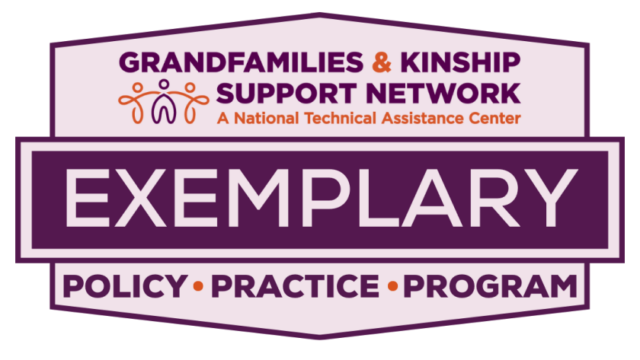Tip Sheet
Caring for a Child Affected by Fetal Alcohol Spectrum Disorder (FASD)
Download This Resource

Your Experience
As a grandparent or other kin caregiver, you are working hard to meet the needs of the child or children in your care. If they were exposed to alcohol before they were born, you might wonder about how you can help them learn and grow.
This resource is designed to provide information about how drinking alcohol during pregnancy can affect children. It also provides kin caregivers with tips for raising children who were exposed to alcohol before birth.
The term “kin caregiver” refers to all individuals who are raising their grandchildren, other relative children, or other children with whom they had a preexisting relationship before taking on primary caregiving responsibility. The families they form with the children in their care are known as kinship families, grandfamilies, and kinship/ grandfamilies, and all three terms can be used interchangeably.
What Is FASD?
Fetal Alcohol Spectrum Disorder (FASD) describes a range of conditions that can develop in a person who was exposed to alcohol before birth. These effects may include physical and learning disabilities as well as behavioral challenges.
Alcohol in the mother’s blood passes to the baby through the umbilical cord. There is no known safe amount of alcohol during pregnancy. And there is no safe time to drink during pregnancy.
What Can You Do to Support Yourself?
If you are raising a child with FASD, you are not alone. Medical and educational professionals can help. So can other kinship/grandfamilies who share your experience and can suggest strategies that have worked for them. What matters most to the child you love is you. Your love, patience, and consistency are the foundation for their learning, growth, and other relationships.
- Take a break when you can. Caring for a young child with FASD is challenging at times, and it is stressful for caregivers. Ask a trusted friend or family member to watch the child for short periods to give yourself a break.
- Build a support network. Reach out to other grandparents or kin caregivers who are caring for children. Contact community organizations such as FASD Support Networks. Look for agencies serving grandparents and/or other kin caregivers and ask if they offer programming or services.
- Reach out for information. Organizations that protect the rights of individuals with intellectual and developmental disabilities can provide advocacy, referrals, and resources. One example is The Arc.
What Are the Signs and Symptoms of FASD?
FASD can be hard to recognize because there is no single test for it. To determine if FASD is a possibility, health care providers will ask about the birth mother’s alcohol use during pregnancy. They will also review the child’s growth, medical history, and overall development, including when the child reached early milestones.
Children with FASD may have a mix of challenges that vary from very mild to significant. Some of the signs and symptoms of FASD that you may see in the child in your care are listed below.
Health Effects MAY Include Any of the Following:
- Prematurity or “Failure to Thrive” – babies may have difficulty gaining and maintaining weight
- Difficulties with sucking (feeding) as a baby
- May have distinctive facial features, such as small lips or a smooth ridge between the nose and upper lip
- Low muscle tone and poor coordination
- Sleep disturbances—may have a hard time going to sleep and wake frequently
- Excessive crying/irritability—babies may be difficult to soothe and comfort
- Vision or hearing problems and/or problems with the heart, kidneys, or bones
Developmental Effects MAY Include Any of the Following:
- Shorter than average height, small head size
- Speech and language delays
- Delays in thinking skills
- Delays in physical skills, like walking or toilet learning
- Poor coping, reasoning, and judgment skills (for example, not understanding the consequences of their actions or having trouble regulating their emotions)
- Difficulty paying attention and following directions
- Poor memory and attention span
- Extreme sensitivity to sound and/or light (children may get easily overwhelmed in stimulating settings like the mall or a school assembly)
- Hyperactive behavior—they may seem to be moving all the time
- Learning disabilities and difficulty in school
As mentioned above, FASD affects different people differently. The child in your care does not have to exhibit all of the signs, symptoms, and developmental effects listed above to receive a diagnosis of FASD.
You can find more information on the Centers for Disease Control and Prevention (CDC) website. The CDC also offers a resource describing expected developmental milestones for babies and children of different ages, from two months through five years.
What Can You Do to Support Children and Adolescents with FASD?
Below, you’ll find some strategies for supporting the child in your care. It is important to share these ideas with the other adults in their lives, such as childcare providers, teachers, and family members.
Reach out to your state or territory’s Early Intervention Contact (for children ages 0-2) or Parent Centers (for children, adolescents, and young adults ages 3-21) as soon as you have concerns about the child’s physical, intellectual, or social-emotional skills. Getting children and adolescents the services they need early helps them reach their full potential. FASD is often not diagnosed until children are school age, or it is mis-diagnosed. Recognizing this delay in diagnoses, some states and territories consider prenatal substance exposure to be an automatic qualifier for services. The Early Childhood Technical Assistance Center has information and a map to help you determine if your state/territory includes prenatal exposure to alcohol or a FASD diagnosis as a qualifying “disability.” For information on getting educational, developmental, and emotional help for a child of any age, from birth through age 21, see the Grandfamilies & Kinship Support Network’s resource, “Supporting Educational Access for Kinship/Grandfamilies.”
Support Learning for Children and Adolescents
- Work with teachers and others to help children identify and develop their strengths and skills. A strengths-based approach can promote the child’s sense of self and confidence.
- Give children time and many chances to learn new things. You may find that the child you care for needs to practice the same skill (like completing a puzzle) or hear the same rule (like hanging up their coat) many, many times before they remember it. FASD affects memory, which makes it more difficult for children to learn and retain new things.
- Be specific about what you mean. Instead of saying, “Clean up your toys,” describe exactly what you want them to do: “Put your cars in the basket.” Allowing a child to complete a task one step at a time helps prevent frustration.
- Give children time to process your words. Children with FASD often need more time to understand, or process, information. When you ask a question, they may take longer to respond. When you are patient, it helps them make sense of your words and develop a response. Recognize that children with FASD are “10-second kids in a 3-second world.”
- Provide close supervision to keep them safe. Because children with FASD often have difficulty understanding cause and effect, they sometimes make impulsive decisions and then are surprised at the outcomes.
- It is helpful for teachers and caregivers to learn about FASD. Share information (in a letter or in a meeting) that describes the child’s likes, dislikes, challenges, and the supports they need. Include the great things about the child along with things they struggle with. Share this information with anyone who cares for or teaches the child.
Promote Social-Emotional Skills
- Talk about emotions. Children with FASD can show a delay in emotional understanding (knowing the causes of emotions in themselves and others). You can help by describing your own feelings (“I’m frustrated that I lost my keys”). You can also notice and name the child’s feelings (“It seems like you are feeling excited about the party”).
- Point out the feelings of peers. Sometimes children with FASD are not aware of how their behaviors affect others. It can help when you point this out in a truthful, but not shaming, way: “When you took Eli’s train out of his hand, he felt sad and angry.”
- Recognize that their ability to manage their feelings may lag behind peers. For example, children with FASD may struggle with self-control or have a hard time coping with “big” feelings like frustration, anger, or sadness. By adjusting your expectations, you may find it easier to understand their behavior and find more patience.
Help Children and Adolescents Regulate Their Emotions
Children with FASD have a hard time regulating their minds and bodies. You can help them manage daily life and teach them coping skills to help them learn how to manage their feelings.
- Develop and follow routines. Children with FASD cope better when they know what to expect. Routines provide the structure they need. Regular mealtimes, a bedtime, and good-bye rituals teach children what they can expect and help them feel safe and secure. Use of a daily schedule, with pictures of each daily activity, helps the child you’re caring for know what is expected of them.
- Notice how they manage sensory information (noise, light, activity, textures, etc.). Children with FASD often have a hard time managing lots of sensory input at one time. If this happens to the child in your care, try using noise-reducing headphones, dimming lights, avoiding scratchy tags, and removing the child from over-stimulating environments.
- Try a range of calming techniques and see which works best. This might be a warm bath, a lullaby, a favorite story or song, gentle rocking, a massage or firm hug, or other soothing techniques (such as a soft brush on the arm, weighted blankets, and sensory toys). Every child is soothed differently.
- Create a safe place to calm down. Give them a place to work through frustration or anger. This isn’t a “time out” used as punishment. Instead, it’s a safe space that might include a favorite stuffed animal, a soft blanket, and a comfortable space to curl up. Try turning down the lights or putting on some relaxing music. Sit with the child if that helps.
- During non-stressful moments, help them practice ways to get calm, like these breathing exercises.
This resource was adapted from an original resource from ZERO TO THREE, with input from the Network and expert review from Gail Engel – a Network subject matter expert, Network management committee member, and GRAND Voice grandparent caregiver – and Hanh Dao – a Network subject matter expert and senior program associate at Children and Family Futures.


